Hyundai Elantra 2017 - RHD (UK. Australia) Service Manual
Manufacturer: HYUNDAI, Model Year: 2017, Model line: Elantra, Model: Hyundai Elantra 2017Pages: 571, PDF Size: 65.66 MB
Page 41 of 571
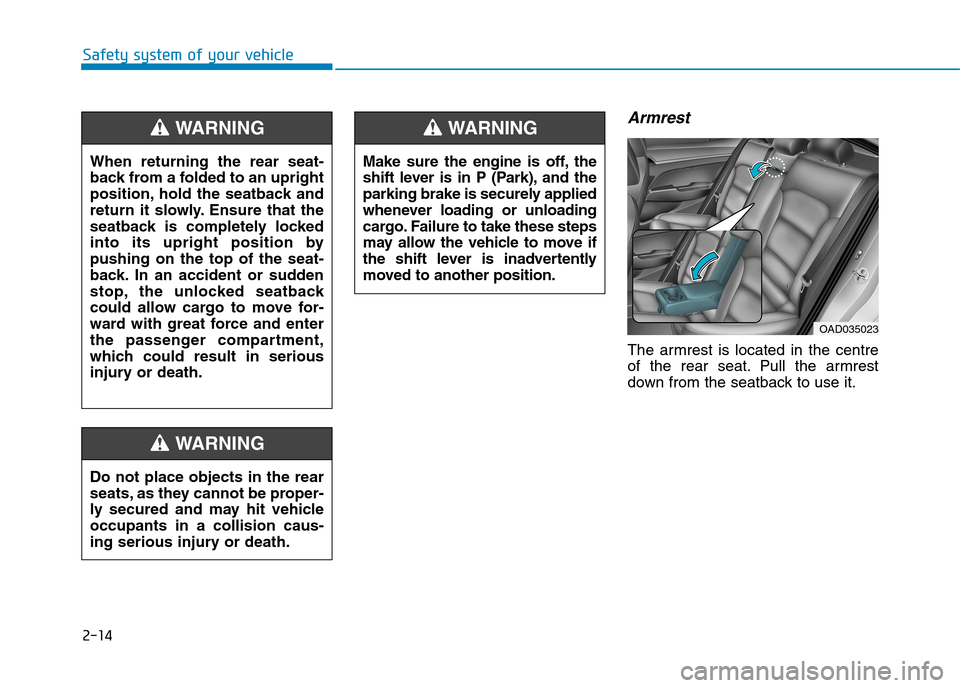
2-14
Safety system of your vehicle
Armrest
The armrest is located in the centre
of the rear seat. Pull the armrest
down from the seatback to use it.
OAD035023
Make sure the engine is off, the
shift lever is in P (Park), and the
parking brake is securely applied
whenever loading or unloading
cargo. Failure to take these steps
may allow the vehicle to move if
the shift lever is inadvertently
moved to another position.
WA R N I N G
Do not place objects in the rear
seats, as they cannot be proper-
ly secured and may hit vehicle
occupants in a collision caus-
ing serious injury or death.
WA R N I N G
When returning the rear seat-
back from a folded to an upright
position, hold the seatback and
return it slowly. Ensure that the
seatback is completely locked
into its upright position by
pushing on the top of the seat-
back. In an accident or sudden
stop, the unlocked seatback
could allow cargo to move for-
ward with great force and enter
the passenger compartment,
which could result in serious
injury or death.
WA R N I N G
Page 42 of 571
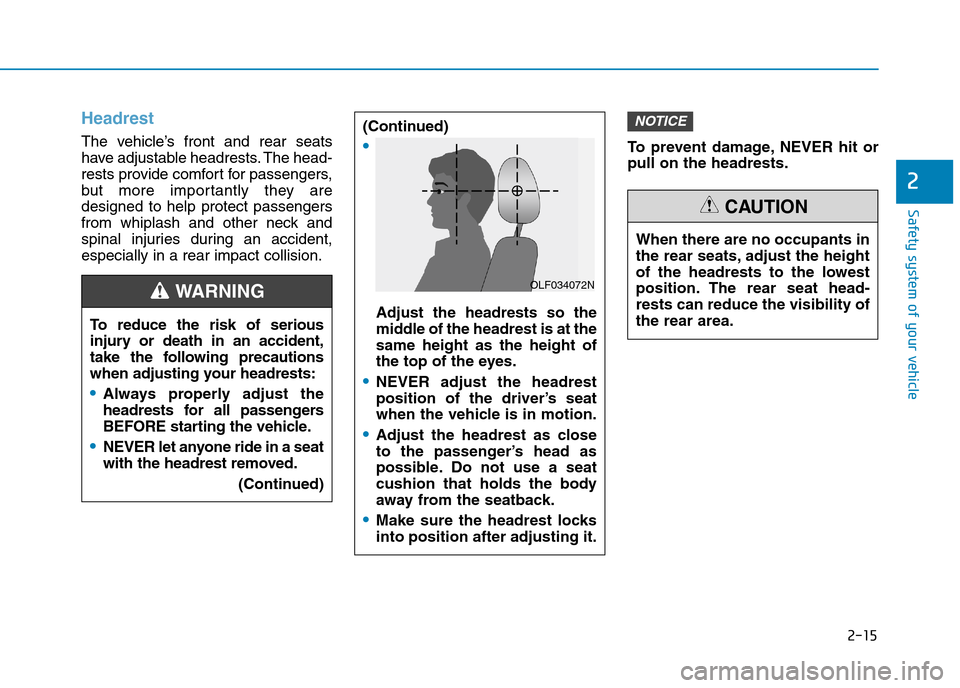
2-15
Safety system of your vehicle
2
Headrest
The vehicle’s front and rear seats
have adjustable headrests. The head-
rests provide comfort for passengers,
but more impor tantly they are
designed to help protect passengers
from whiplash and other neck and
spinal injuries during an accident,
especially in a rear impact collision.
To p r e v e n t d a m a g e , N E V E R h i t o r
pull on the headrests.
NOTICE(Continued)
•
Adjust the headrests so the
middle of the headrest is at the
same height as the height of
the top of the eyes.
•NEVER adjust the headrest
position of the driver’s seat
when the vehicle is in motion.
•Adjust the headrest as close
to the passenger’s head as
possible. Do not use a seat
cushion that holds the body
away from the seatback.
•Make sure the headrest locks
into position after adjusting it.
OLF034072N
To r e d u c e t h e r i s k o f s e r i o u s
injury or death in an accident,
take the following precautions
when adjusting your headrests:
•Always properly adjust the
headrests for all passengers
BEFORE starting the vehicle.
•NEVER let anyone ride in a seat
with the headrest removed.
(Continued)
WA R N I N G
When there are no occupants in
the rear seats, adjust the height
of the headrests to the lowest
position. The rear seat head-
rests can reduce the visibility of
the rear area.
CAUTION
Page 43 of 571
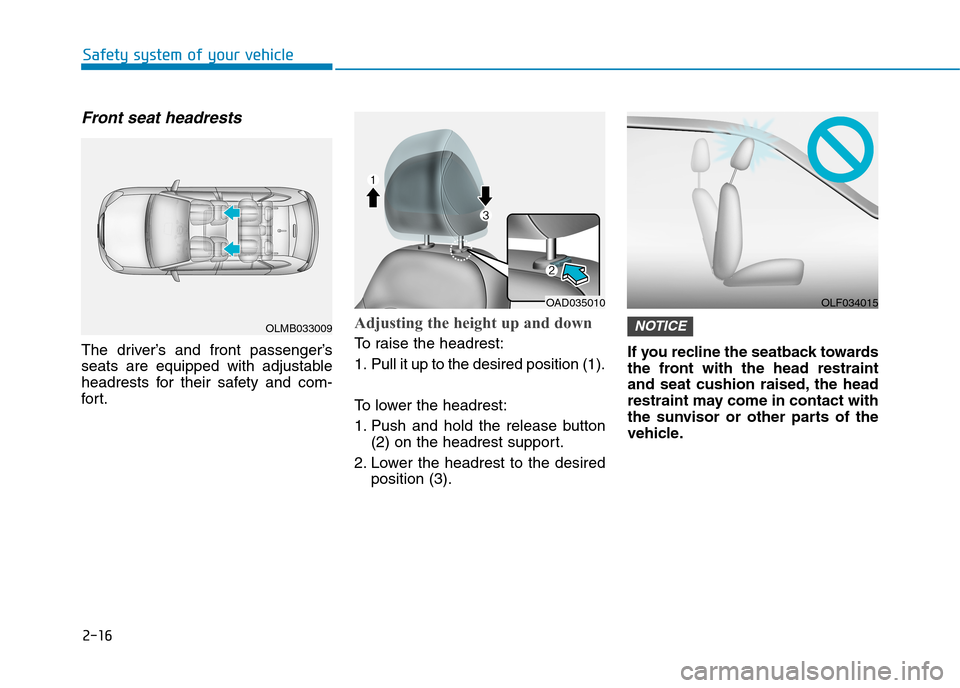
2-16
Safety system of your vehicle
Front seat headrests
The driver’s and front passenger’s
seats are equipped with adjustable
headrests for their safety and com-
for t.
Adjusting the height up and down
To r a i s e t h e h e a d r e s t :
1. Pull it up to the desired position (1).
To l o w e r t h e h e a d r e s t :
1. Push and hold the release button
(2) on the headrest support.
2. Lower the headrest to the desired
position (3).
If you recline the seatback towards
the front with the head restraint
and seat cushion raised, the head
restraint may come in contact with
the sunvisor or other parts of the
vehicle.
NOTICE
OAD035010OLF034015
OLMB033009
Page 44 of 571
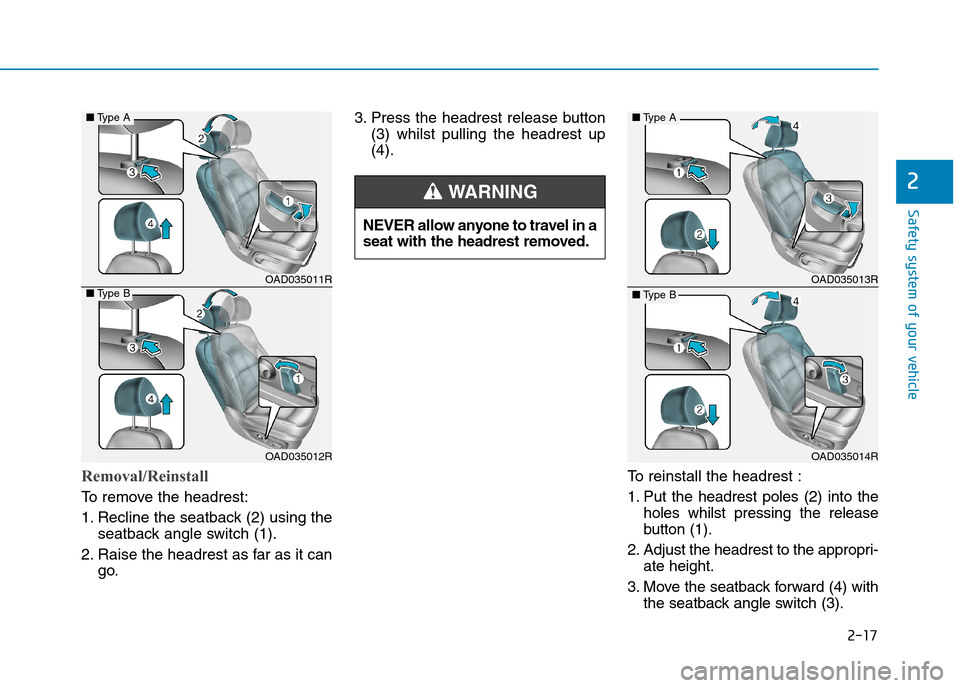
2-17
Safety system of your vehicle
Removal/Reinstall
To r e m o v e t h e h e a d r e s t :
1. Recline the seatback (2) using the
seatback angle switch (1).
2. Raise the headrest as far as it can
go.
3. Press the headrest release button
(3) whilst pulling the headrest up
(4).
To r e i n s t a l l t h e h e a d r e s t :
1. Put the headrest poles (2) into the
holes whilst pressing the release
button (1).
2. Adjust the headrest to the appropri-
ate height.
3. Move the seatback forward (4) with
the seatback angle switch (3).
2
NEVER allow anyone to travel in a
seat with the headrest removed.
WA R N I N G
OAD035011R
OAD035012R
■Ty p e A
■Ty p e BOAD035013R
OAD035014R
■Ty p e A
■Ty p e B
Page 45 of 571
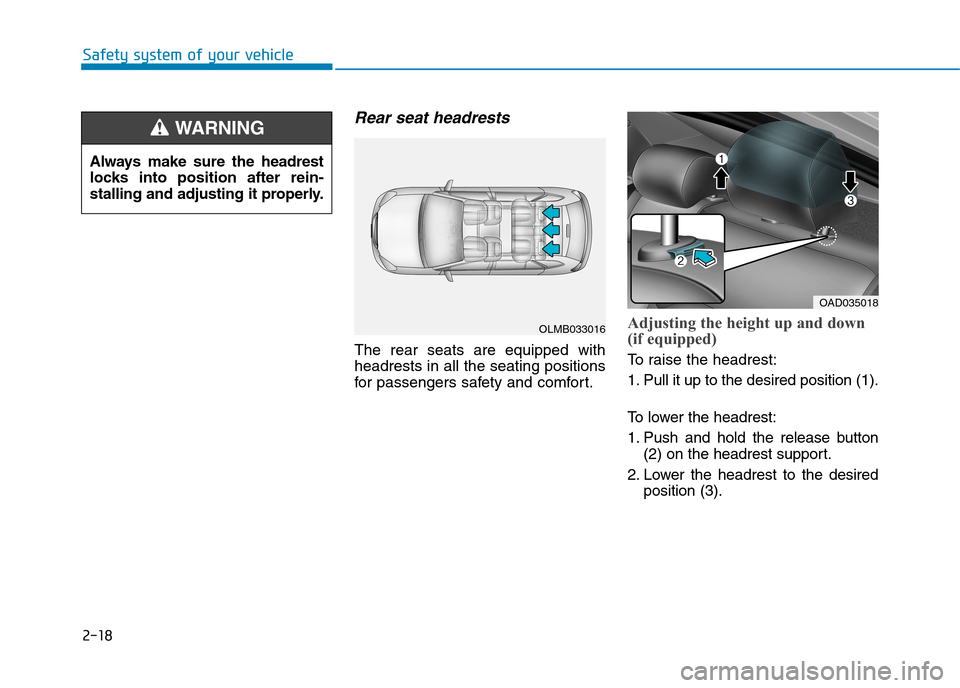
2-18
Rear seat headrests
The rear seats are equipped with
headrests in all the seating positions
for passengers safety and comfor t.
Adjusting the height up and down
(if equipped)
To r a i s e t h e h e a d r e s t :
1. Pull it up to the desired position (1).
To l o w e r t h e h e a d r e s t :
1. Push and hold the release button
(2) on the headrest support.
2. Lower the headrest to the desired
position (3).
Safety system of your vehicle
OLMB033016
OAD035018
Always make sure the headrest
locks into position after rein-
stalling and adjusting it properly.
WA R N I N G
Page 46 of 571
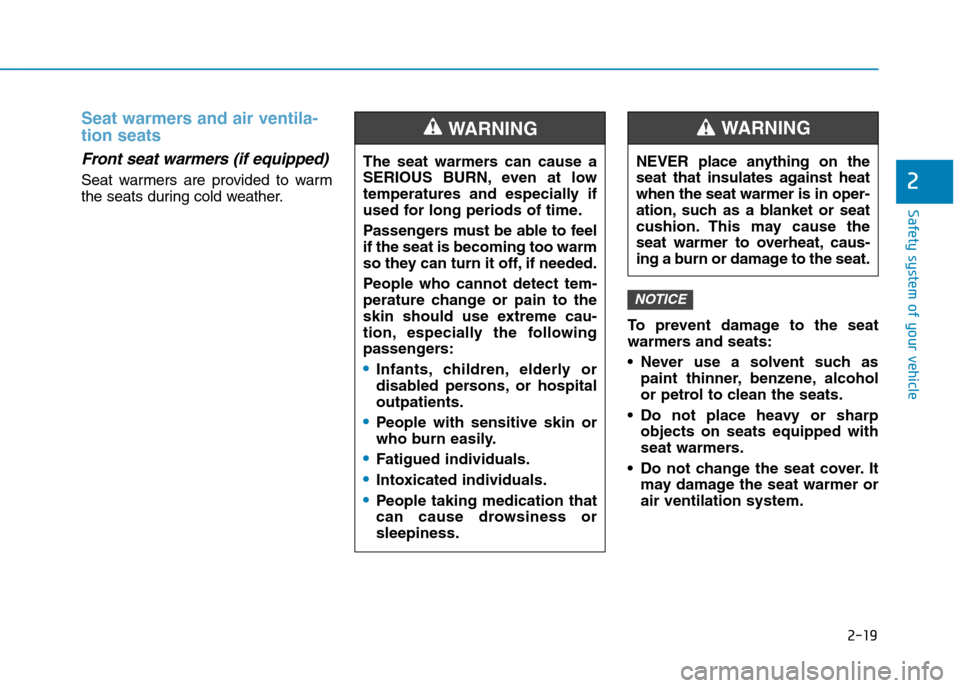
2-19
Safety system of your vehicle
2
Seat warmers and air ventila-
tion seats
Front seat warmers (if equipped)
Seat warmers are provided to warm
the seats during cold weather.
To p r e v e n t d a m a g e t o t h e s e a t
warmers and seats:
•Never use a solvent such as
paint thinner, benzene, alcohol
or petrol to clean the seats.
•Do not place heavy or sharp
objects on seats equipped with
seat warmers.
•Do not change the seat cover.It
may damage the seat warmer or
air ventilation system.
NOTICE
The seat warmers can cause a
SERIOUS BURN, even at low
temperatures and especially if
used for long periods of time.
Passengers must be able to feel
if the seat is becoming too warm
so they can turn it off, if needed.
People who cannot detect tem-
perature change or pain to the
skin should use extreme cau-
tion, especially the following
passengers:
•Infants, children, elderly or
disabled persons, or hospital
outpatients.
•People with sensitive skin or
who burn easily.
•Fatigued individuals.
•Intoxicated individuals.
•People taking medication that
can cause drowsiness or
sleepiness.
WA R N I N G
NEVER place anything on the
seat that insulates against heat
when the seat warmer is in oper-
ation, such as a blanket or seat
cushion. This may cause the
seat warmer to overheat, caus-
ing a burn or damage to the seat.
WA R N I N G
Page 47 of 571
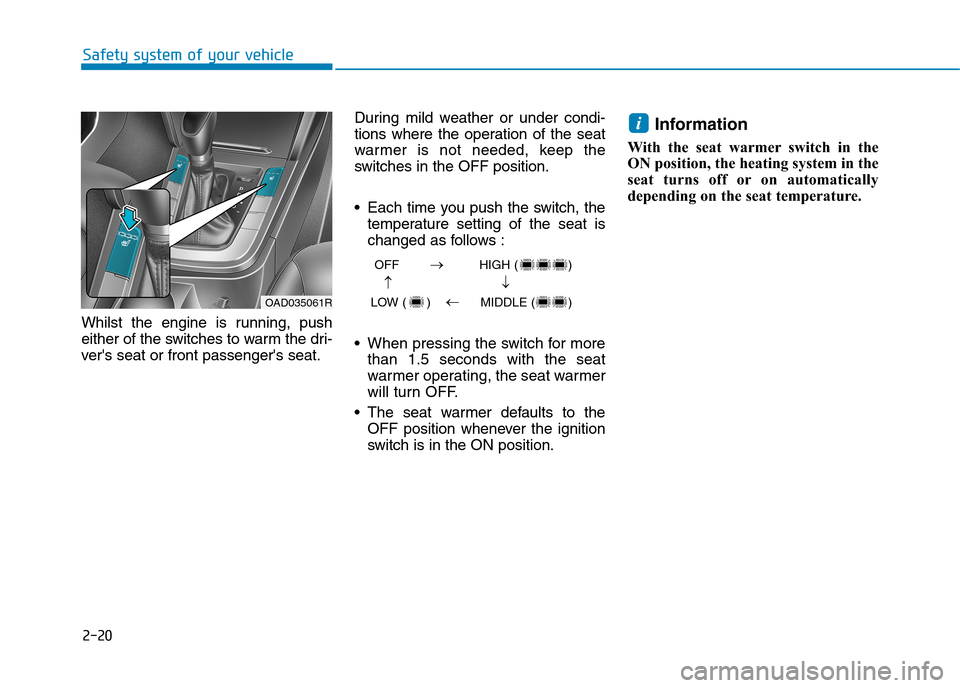
2-20
Safety system of your vehicle
Whilst the engine is running, push
either of the switches to warm the dri-
ver's seat or front passenger's seat.
During mild weather or under condi-
tions where the operation of the seat
warmer is not needed, keep the
switches in the OFF position.
•Each time you push the switch, the
temperature setting of the seat is
changed as follows :
•When pressing the switch for more
than 1.5 seconds with the seat
warmer operating, the seat warmer
will turn OFF.
•The seat warmer defaults to the
OFF position whenever the ignition
switch is in the ON position.
Information
With the seat warmer switch in the
ON position, the heating system in the
seat turns off or on automatically
depending on the seat temperature.
i
OFF HIGH ( )
LOW ( ) MIDDLE ( )
→→
→
→
OAD035061R
Page 48 of 571
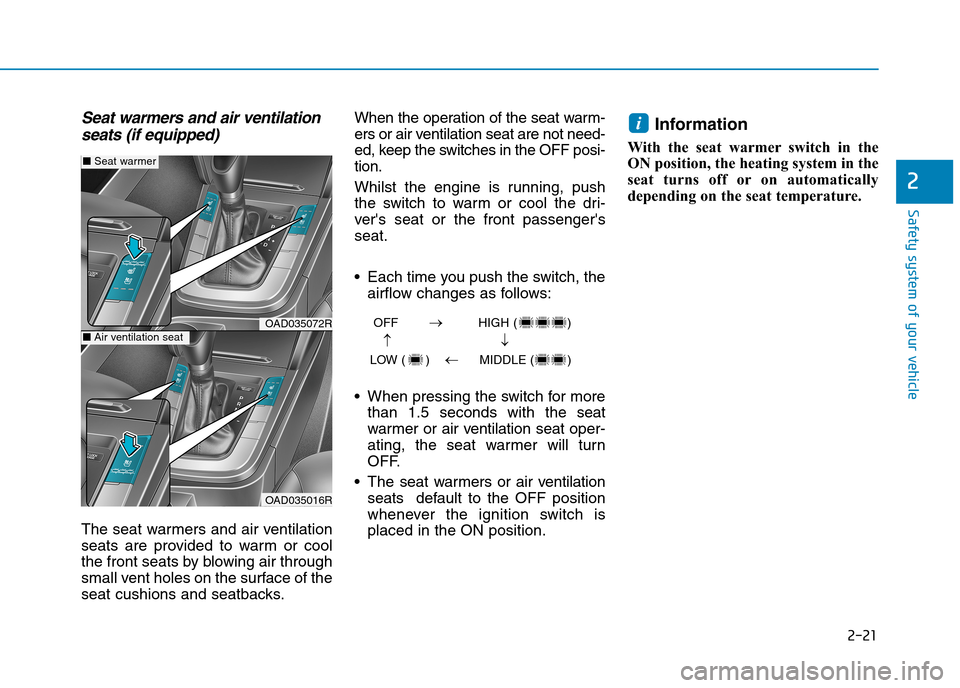
2-21
Safety system of your vehicle
2
Seat warmers and air ventilation
seats (if equipped)
The seat warmers and air ventilation
seats are provided to warm or cool
the front seats by blowing air through
small vent holes on the surface of the
seat cushions and seatbacks.
When the operation of the seat warm-
ers or air ventilation seat are not need-
ed, keep the switches in the OFF posi-
tion.
Whilst the engine is running, push
the switch to warm or cool the dri-
ver's seat or the front passenger's
seat.
•Each time you push the switch, the
airflow changes as follows:
•When pressing the switch for more
than 1.5 seconds with the seat
warmer or air ventilation seat oper-
ating, the seat warmer will turn
OFF.
•The seat warmers or air ventilation
seats default to the OFF position
whenever the ignition switch is
placed in the ON position.
Information
With the seat warmer switch in the
ON position, the heating system in the
seat turns off or on automatically
depending on the seat temperature.
i
OFF HIGH ( )
LOW ( ) MIDDLE ( )
→→
→
→OAD035072R
OAD035016R
■Seat warmer
■Air ventilation seat
Page 49 of 571
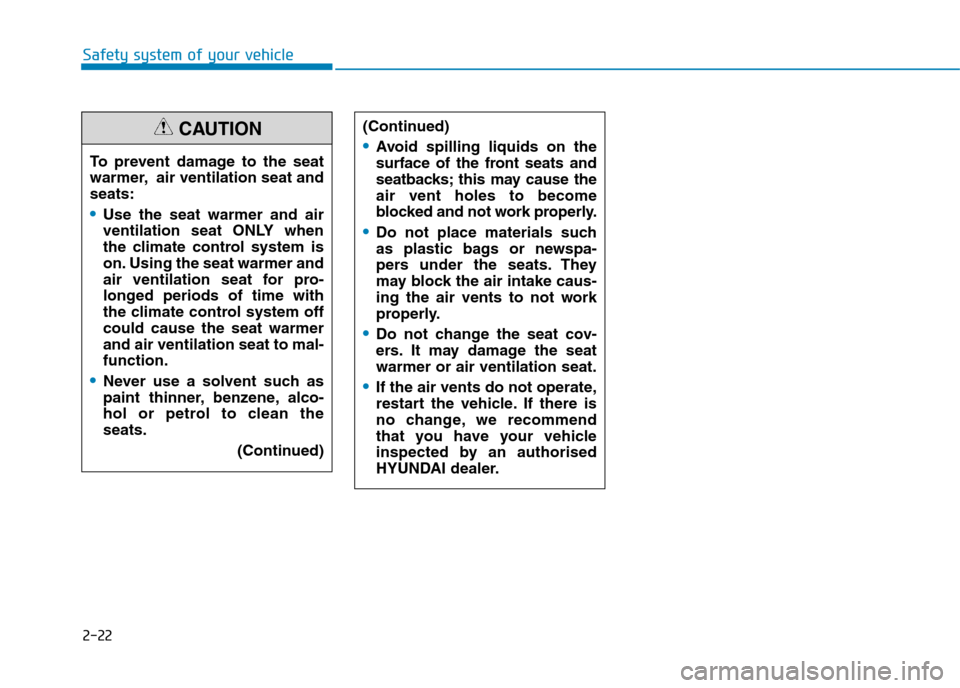
2-22
Safety system of your vehicle
(Continued)
•Avoid spilling liquids on the
surface of the front seats and
seatbacks; this may cause the
air vent holes to become
blocked and not work properly.
•Do not place materials such
as plastic bags or newspa-
pers under the seats. They
may block the air intake caus-
ing the air vents to not work
properly.
•Do not change the seat cov-
ers. It may damage the seat
warmer or air ventilation seat.
•If the air vents do not operate,
restart the vehicle. If there is
no change, we recommend
that you have your vehicle
inspected by an authorised
HYUNDAI dealer.
To p r e v e n t d a m a g e t o t h e s e a t
warmer, air ventilation seat and
seats:
•Use the seat warmer and air
ventilation seat ONLY when
the climate control system is
on. Using the seat warmer and
air ventilation seat for pro-
longed periods of time with
the climate control system off
could cause the seat warmer
and air ventilation seat to mal-
function.
•Never use a solvent such as
paint thinner, benzene, alco-
hol or petrol to clean the
seats.
(Continued)
CAUTION
Page 50 of 571
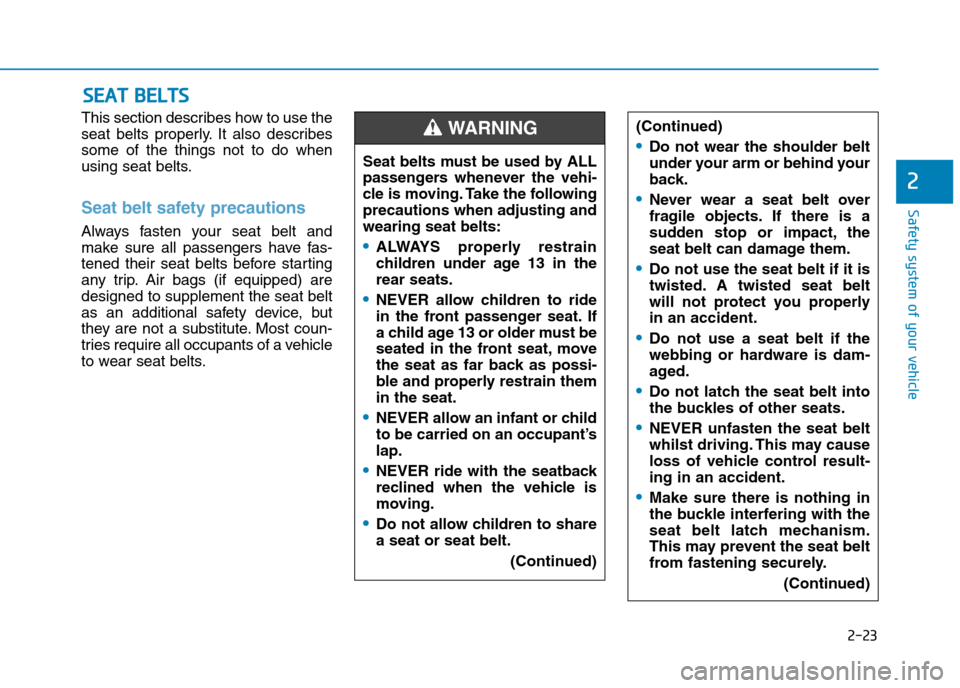
2-23
Safety system of your vehicle
2
This section describes how to use the
seat belts properly. It also describes
some of the things not to do when
using seat belts.
Seat belt safety precautions
Always fasten your seat belt and
make sure all passengers have fas-
tened their seat belts before starting
any trip. Air bags (if equipped) are
designed to supplement the seat belt
as an additional safety device, but
they are not a substitute. Most coun-
tries require all occupants of a vehicle
to wear seat belts.
SSEEAATT BBEELLTTSS
Seat belts must be used by ALL
passengers whenever the vehi-
cle is moving. Take the following
precautions when adjusting and
wearing seat belts:
•ALWAYS properly restrain
children under age 13 in the
rear seats.
•NEVER allow children to ride
in the front passenger seat. If
a child age 13 or older must be
seated in the front seat, move
the seat as far back as possi-
ble and properly restrain them
in the seat.
•NEVER allow an infant or child
to be carried on an occupant’s
lap.
•NEVER ride with the seatback
reclined when the vehicle is
moving.
•Do not allow children to share
a seat or seat belt.
(Continued)
WA R N I N G (Continued)
•Do not wear the shoulder belt
under your arm or behind your
back.
•Never wear a seat belt over
fragile objects. If there is a
sudden stop or impact, the
seat belt can damage them.
•Do not use the seat belt if it is
twisted. A twisted seat belt
will not protect you properly
in an accident.
•Do not use a seat belt if the
webbing or hardware is dam-
aged.
•Do not latch the seat belt into
the buckles of other seats.
•NEVER unfasten the seat belt
whilst driving. This may cause
loss of vehicle control result-
ing in an accident.
•Make sure there is nothing in
the buckle interfering with the
seat belt latch mechanism.
This may prevent the seat belt
from fastening securely.
(Continued)